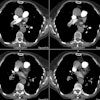Predictors of patient response to pulmonary thromboendarterectomy.
Bergin CJ, Sirlin C, Deutsch R, Fedullo P, Hauschildt J, Huynh T, Auger W, Brown M
Department of Radiology, University of California, San Diego 92103, USA.
OBJECTIVE: We sought to identify imaging features that help predict surgical success in patients undergoing thromboendarterectomy. MATERIALS AND METHODS: Thirty-nine consecutive patients who underwent pulmonary angiography and thromboendarterectomy during 1995 and 1996 were included. Thirty-four underwent helical CT angiography. Measurements of postoperative pulmonary vascular resistance were compared with preoperative imaging features and preoperative pulmonary vascular resistance. RESULTS: The best imaging indicators of a relatively high postoperative pulmonary vascular resistance were the extent of small vessel disease identified on CT angiograms as segments with abnormal perfusion but normal segmental arteries (p = 0.005) and the extent of central disease (p = 0.015). Combined with preoperative pulmonary vascular resistance, these features had a strong correlation with postoperative outcome (p = 0.0005). Segmental arterial disease seen on both conventional angiography and CT angiography correlated poorly with surgical outcome. CONCLUSION: In patients with chronic thromboembolic pulmonary hypertension, CT angiographic evidence of extensive central vessel disease and limited small vessel involvement indicates a favorable surgical outcome.







